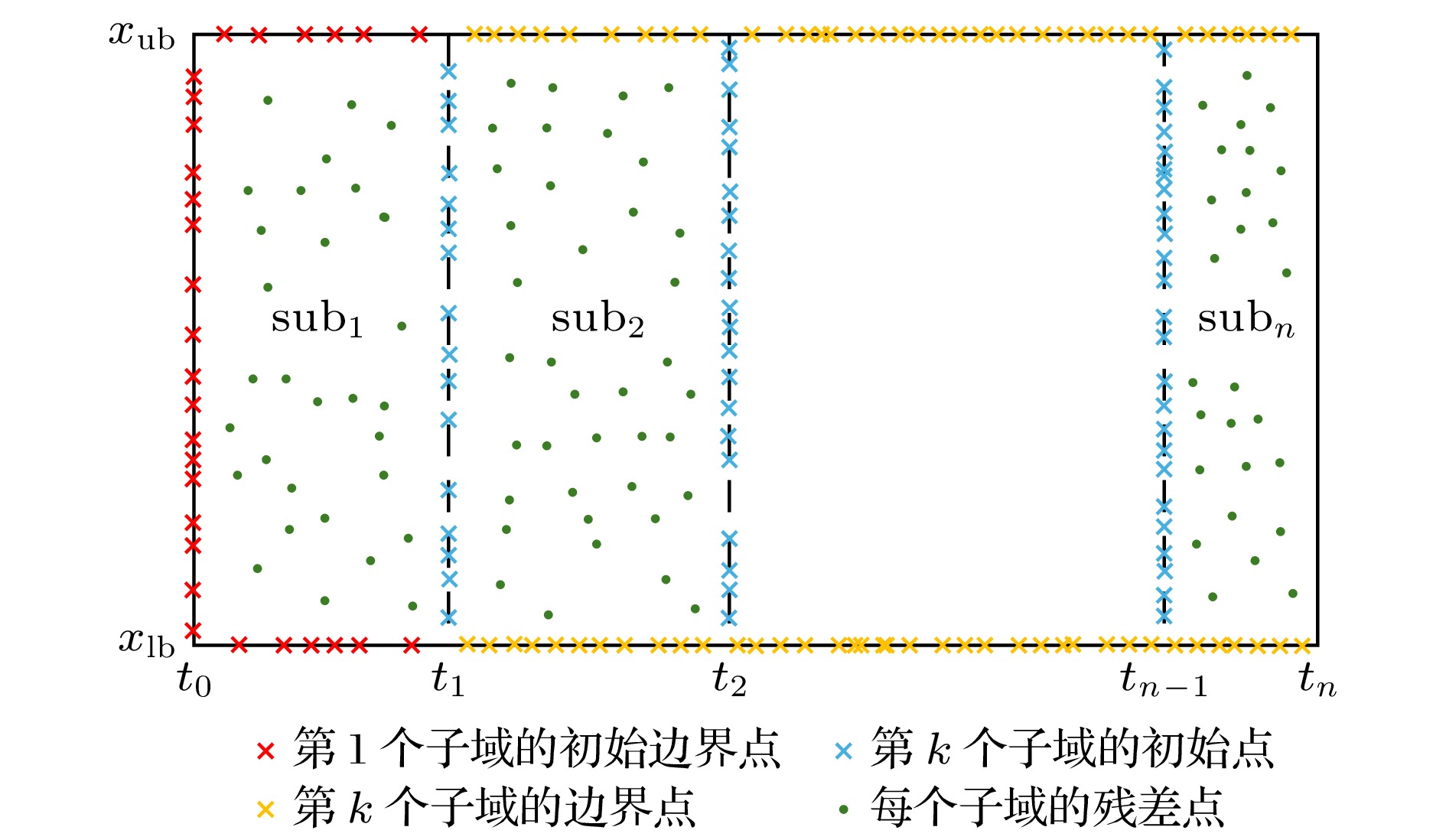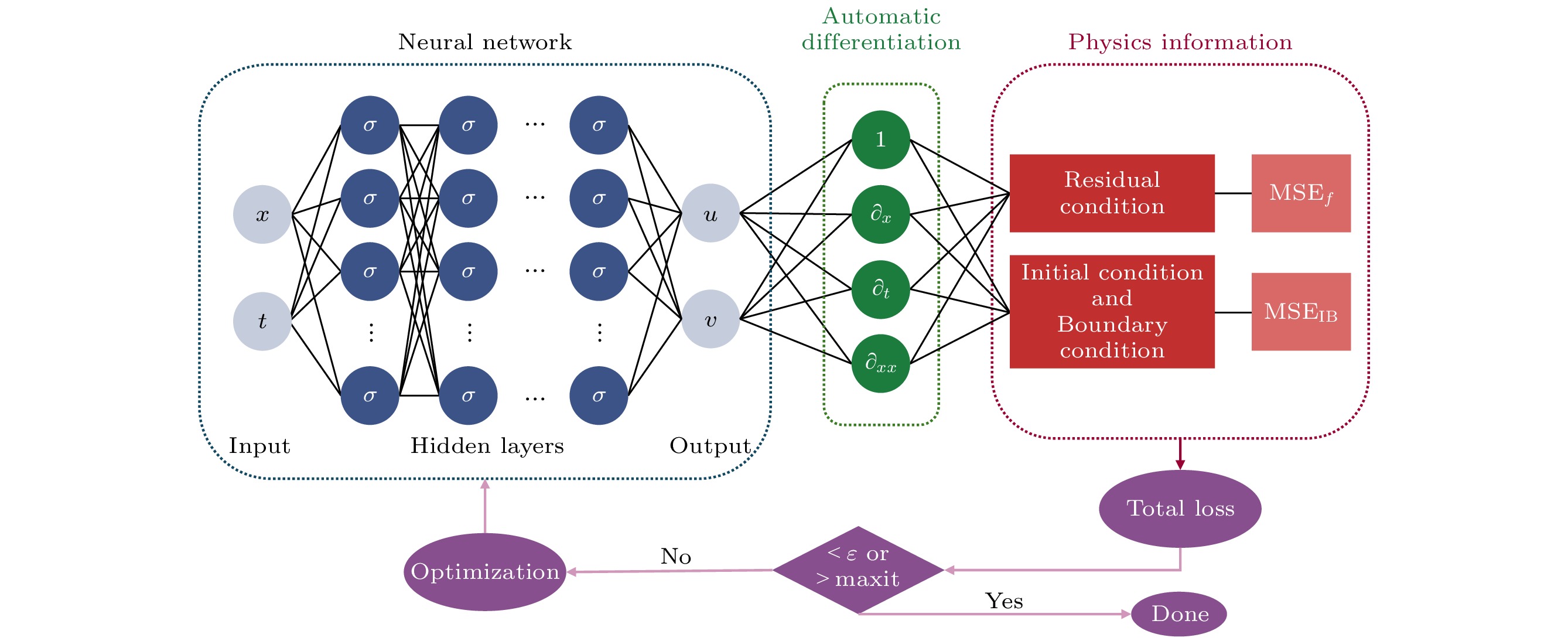-
In recent years, physics-informed neural networks (PINNs) have provided effcient data-driven methods for solving forward and inverse problems of partial differential equations (PDEs). However, when addressing complex PDEs, PINNs face significant challenges in computational efficiency and accuracy. In this study, we propose the extended mixed-training physics-informed neural networks (X-MTPINNs) as illustrated in the following figure, which effectively enhance the ability to solve nonlinear wave problems by integrating the domain decomposition technique of extended physics-informed neural networks (X-PINNs) in a mixed-training physics-informed neural networks (MTPINNs) framework. Compared with the classical PINNs model, the new model exhibits dual advantages: The first advantage is that the mixed-training framework significantly improves convergence properties by optimizing the handling mechanism of initial and boundary conditions, achieving higher fitting accuracy for nonlinear wave solutions while reducing the computation time by approximately 40%. And the second advantage is that the domain decomposition technique from X-PINNs strengthens the ability of the model to represent complex dynamical behaviors. Numerical experiments based on the nonlinear Schrödinger equation (NLSE) demonstrate that X-MTPINNs excel perform well in solving two bright solitons, third-order rogue waves, and parameter inversion tasks, with prediction accuracy improved by one to two orders of magnitude over traditional PINN. For inverse problems, the X-MTPINNs algorithm accurately identifies unknown parameters in the NLSE under noise-free, 2%, and 5% noisy conditions, solving the complete failure problem of NSLE parameter identification in classical PINNs in the studied scenario, thus demonstrating strong robustness.
-
Keywords:
- physics-informed neural networks /
- nonlinear Schrödinger equation /
- extended mixed-training physics-informed neural networks /
- domain decomposition /
- parameter identification
[1] Dissanayake M, Phan-Thien N 1994 Commun. Numer. Methods Eng. 10 195
 Google Scholar
Google Scholar
[2] Lagaris I E, Likas A 1998 IEEE Trans. Neural Networks 9 987
 Google Scholar
Google Scholar
[3] Eymard R, Gallouët T, Herbin R 2000 Handb. Numer. Anal. 7 713
[4] Zhang Y 2009 Appl. Math. Comput. 215 524
[5] Taylor C A, Hughes T J R, Zarins C K 1998 Comput. Methods Appl. Mech. Eng. 158 155
 Google Scholar
Google Scholar
[6] He K M, Zhang X Y, Ren S Q, Sun J 2016 CPRV 2016-December 770
[7] Ding Y, Li J T, Zhang J X, Li P P, Bai H, Fang B, Fang H X, Huang K, Wang G Y, Nowell C J, Voelcker N H, Peng B, Li L, Huang W 2025 Nat. Commun. 16 743
 Google Scholar
Google Scholar
[8] Liu J, Chen Y B, Liu K, Zhao J 2018 32nd AAAI Conference on Artificial Intelligence New Orleans, Louisiana, USA, February 2–7, 2018 p4865
[9] Raissi M, Perdikaris P, Karniadakis G E 2019 J. Comput. Phys. 378 686
 Google Scholar
Google Scholar
[10] Wang F J, Zhai Z, Zhao Z B, Di Y, Chen X F 2024 Nat. Commun. 15 4332
 Google Scholar
Google Scholar
[11] James D, Alireza D, Soroush A 2019 Sci. Total Environ. 912 168814
[12] Xu S F, Sun Z X, Huang R F, Guo D L, Yang G W, Ju S J 2023 AMS 39 322302
[13] Chiu P H, Wong J C, Ooi C C, Dao H 2022 Comput. Methods Appl. Mech. Eng. 395 114909
 Google Scholar
Google Scholar
[14] Yang L, Meng X H, Karniadakis G E 2021 J. Comput. Phys. 425 109913
 Google Scholar
Google Scholar
[15] Mojgani R, Balajewicz M, Hassanzadeh P 2023 Comput. Methods Appl. Mech. Eng. 404 115810
 Google Scholar
Google Scholar
[16] Jagtap A D, Karniadakis G E 2021 CEUR Workshop Proc. 296 4
[17] Che W J, Chen S C, Liu C, Zhao L C, Akhmediev N 2022 Phys. Rev. A 105 043526
 Google Scholar
Google Scholar
[18] Liu C, Chen S C, Yao X K, Akhmediev N 2022 Physica D 433 133192
 Google Scholar
Google Scholar
[19] Fang Y, Bo W B, Wang R R, Wang Y Y, Dai C Q 2022 Chaos, Solitons Fractals 165 112908
 Google Scholar
Google Scholar
[20] Li W T, Chen Y P, Zhang Z, Yang X Y, Li B 2025 Chin. Phys. Lett. 42 010202
 Google Scholar
Google Scholar
[21] Chen M, Wang Z 2023 Chin. Phys. B 32 090504
 Google Scholar
Google Scholar
[22] Li J, Chen Y 2020 Commun. Theor. Phys. 72 105005
 Google Scholar
Google Scholar
[23] Li J, Chen Y 2020 Commun. Theor. Phys. 72 115003
 Google Scholar
Google Scholar
[24] Song J, Zhong M, Karniadakis G E, Yan Z Y 2024 J. Comput. Phys. 505 112917
 Google Scholar
Google Scholar
[25] Wang X L, Wu Z K, Song J, Han W J, Yan Z Y 2024 Chaos, Solitons Fractals 180 114509
 Google Scholar
Google Scholar
[26] Qiu T W, Wei G M, Song Y X, Wang Z 2025 Appl. Math. Mech. 46 105
 Google Scholar
Google Scholar
[27] 田十方, 李彪 2023 物理学报 72 100202
 Google Scholar
Google Scholar
Tian S F, Li B 2023 Acta Phys. Sin. 72 100202
 Google Scholar
Google Scholar
[28] Li J H, Li B 2022 Chaos, Solitons Fractals 164 112712
 Google Scholar
Google Scholar
[29] Tian S F, Li B, Zhang Z 2024 Chin. Phys. Lett. 41 030201
 Google Scholar
Google Scholar
[30] Zhou H J, Pu J C, Chen Y 2023 Nonlinear Dyn. 111 14667
 Google Scholar
Google Scholar
[31] Qiu W X, Si Z Z, Mou D S, Dai C Q, Li J T, Liu W 2025 Nonlinear Dyn. 113 4063
 Google Scholar
Google Scholar
[32] Liu X M, Zhang Z Y, Liu W J 2023 Chin. Phys. Lett. 40 070501
 Google Scholar
Google Scholar
[33] Liu H Y, Zhang Y B, Wang L 2024 J. Syst. Sci. 37 494
 Google Scholar
Google Scholar
[34] Zhang W X, Chen Y 2025 Nonlinear Dyn. 113 10211
 Google Scholar
Google Scholar
[35] Pu J C, Chen Y 2024 J. Comput. Phys. 510 113090
 Google Scholar
Google Scholar
[36] 张解放, 戴朝卿, 王悦悦 2016 基于非线性薛定谔方程的畸形波理论及其应用(北京: 科学出版社) 第44—63页
Zhang J F, Dai C Q, Wang Y Y 2016 Rogue Wave Theory and Its Applications Based on the Nonlinear Schrödinger Equation (Beijing: Science Press) pp44–63
-
表 1 两种模型对NLSE亮双孤子解的数值预测结果
Table 1. Numerical prediction results of two models for two bright solitons in the NLSE
亮双孤子 子域 隐藏
层数神经
元数L2误差 训练时间/s X-
MTPINNs[–5.00, –3.30] 4 50 4.52×10–2 2531.88 [–3.30, –2.50] 4 50 2.63×10–2 2459.23 [–2.50, –1.40] 4 50 3.03×10–2 2347.56 [–1.40, 2.00] 4 50 5.73×10–2 2489.87 [2.00, 5.00] 4 50 1.70×10–2 2489.87 Global [–5, 5] 4 50 3.38×10–2 2531.88 PINNs [–5, 5] 4 50 2.51×10–1 4176.69 表 2 两种模型对非线性薛定谔方程三阶怪波的数值预测结果
Table 2. Numerical prediction results of third-order rogue waves in the NLSE
三阶怪波 子域 隐藏
层数神经
元数L2误差 训练时间/s X-
MTPINNs[–2.00, –0.60] 4 50 1.25×10–3 3065.07 [–0.60, –0.15] 4 50 1.22×10–3 2228.26 [–0.15, 0.15] 4 50 3.89×10–3 2018.29 [0.15, 0.60] 4 50 1.31×10–3 2438.84 [0.60, 2.00] 4 50 1.84×10–3 2339.57 Global [–2, 2] 4 50 2.25×10–3 3065.07 PINNs [–2, 2] 4 50 4.94×10–1 5538.17 表 3 通过学习所得的$ \lambda_1 $和$ \lambda_2 $及其误差
Table 3. Learned $ \lambda_1 $ and $ \lambda_2 $ and their associated errors
NPDEs 噪声 非线性演化方程 相对误差$ [\lambda_1, \lambda_2] $/% Correct — $ {\rm{i}}\hat{h}_t + 0.5\hat{h}_{xx} + |\hat{h}|^2\hat{h} = 0 $ $ [0, 0] $ [–2.00, –0.60] 0% $ \lambda_1 = 0.4999224, \lambda_2 = 0.9999491 $ $ [0.01553, 0.00509] $ 2% $ \lambda_1 = 0.5006779, \lambda_2 = 1.0010909 $ $ [0.13558, 0.10909] $ 5% $ \lambda_1 = 0.5017547, \lambda_2 = 1.0026274 $ $ [0.35094, 0.26274] $ [–0.60, –0.08] 0% $ \lambda_1 = 0.4995355, \lambda_2 = 0.9997470 $ $ [0.09289, 0.02530] $ 2% $ \lambda_1 = 0.4990919, \lambda_2 = 0.9979020 $ $ [0.18162, 0.20980] $ 5% $ \lambda_1 = 0.4983062, \lambda_2 = 0.9952767 $ $ [0.33876, 0.47233] $ [–0.08, 0.00] 0% $ \lambda_1 = 0.4907891, \lambda_2 = 0.9970491 $ $ [1.84218, 0.29509] $ 2% $ \lambda_1 = 0.4856022, \lambda_2 = 0.9931418 $ $ [2.87955, 0.68582] $ 5% $ \lambda_1 = 0.4838027, \lambda_2 = 0.9913622 $ $ [3.23946, 0.86378] $ [0.00, 0.08] 0% $ \lambda_1 = 0.4978686, \lambda_2 = 0.9941696 $ $ [0.42627, 0.58304] $ 2% $ \lambda_1 = 0.4953954, \lambda_2 = 0.9936743 $ $ [0.92092, 0.63257] $ 5% $ \lambda_1 = 0.4909737, \lambda_2 = 0.9887489 $ $ [1.80527, 1.12511] $ [0.08, 0.60] 0% $ \lambda_1 = 0.4999007, \lambda_2 = 0.9997627 $ $ [0.01987, 0.02373] $ 2% $ \lambda_1 = 0.4997132, \lambda_2 = 0.9992683 $ $ [0.05737, 0.07317] $ 5% $ \lambda_1 = 0.4974256, \lambda_2 = 0.9973150 $ $ [0.51489, 0.26850] $ [0.60, 2.00] 0% $ \lambda_1 = 0.5002598, \lambda_2 = 1.0001861 $ $ [0.05195, 0.01861] $ 2% $ \lambda_1 = 0.4997032, \lambda_2 = 0.9999705 $ $ [0.05936, 0.00295] $ 5% $ \lambda_1 = 0.4995049, \lambda_2 = 0.9998789 $ $ [0.09903, 0.01211] $ Global 0% $ \lambda_1 = 0.972926, \lambda_2 = 0.9987469 $ $ [0.54148, 0.12531] $ 2% $ \lambda_1 = 0.5035173, \lambda_2 = 0.9971460 $ $ [0.70345, 0.28540] $ 5% $ \lambda_1 = 4.9470665, \lambda_2 = 1.0050076 $ $ [1.05867, 0.50076] $ -
[1] Dissanayake M, Phan-Thien N 1994 Commun. Numer. Methods Eng. 10 195
 Google Scholar
Google Scholar
[2] Lagaris I E, Likas A 1998 IEEE Trans. Neural Networks 9 987
 Google Scholar
Google Scholar
[3] Eymard R, Gallouët T, Herbin R 2000 Handb. Numer. Anal. 7 713
[4] Zhang Y 2009 Appl. Math. Comput. 215 524
[5] Taylor C A, Hughes T J R, Zarins C K 1998 Comput. Methods Appl. Mech. Eng. 158 155
 Google Scholar
Google Scholar
[6] He K M, Zhang X Y, Ren S Q, Sun J 2016 CPRV 2016-December 770
[7] Ding Y, Li J T, Zhang J X, Li P P, Bai H, Fang B, Fang H X, Huang K, Wang G Y, Nowell C J, Voelcker N H, Peng B, Li L, Huang W 2025 Nat. Commun. 16 743
 Google Scholar
Google Scholar
[8] Liu J, Chen Y B, Liu K, Zhao J 2018 32nd AAAI Conference on Artificial Intelligence New Orleans, Louisiana, USA, February 2–7, 2018 p4865
[9] Raissi M, Perdikaris P, Karniadakis G E 2019 J. Comput. Phys. 378 686
 Google Scholar
Google Scholar
[10] Wang F J, Zhai Z, Zhao Z B, Di Y, Chen X F 2024 Nat. Commun. 15 4332
 Google Scholar
Google Scholar
[11] James D, Alireza D, Soroush A 2019 Sci. Total Environ. 912 168814
[12] Xu S F, Sun Z X, Huang R F, Guo D L, Yang G W, Ju S J 2023 AMS 39 322302
[13] Chiu P H, Wong J C, Ooi C C, Dao H 2022 Comput. Methods Appl. Mech. Eng. 395 114909
 Google Scholar
Google Scholar
[14] Yang L, Meng X H, Karniadakis G E 2021 J. Comput. Phys. 425 109913
 Google Scholar
Google Scholar
[15] Mojgani R, Balajewicz M, Hassanzadeh P 2023 Comput. Methods Appl. Mech. Eng. 404 115810
 Google Scholar
Google Scholar
[16] Jagtap A D, Karniadakis G E 2021 CEUR Workshop Proc. 296 4
[17] Che W J, Chen S C, Liu C, Zhao L C, Akhmediev N 2022 Phys. Rev. A 105 043526
 Google Scholar
Google Scholar
[18] Liu C, Chen S C, Yao X K, Akhmediev N 2022 Physica D 433 133192
 Google Scholar
Google Scholar
[19] Fang Y, Bo W B, Wang R R, Wang Y Y, Dai C Q 2022 Chaos, Solitons Fractals 165 112908
 Google Scholar
Google Scholar
[20] Li W T, Chen Y P, Zhang Z, Yang X Y, Li B 2025 Chin. Phys. Lett. 42 010202
 Google Scholar
Google Scholar
[21] Chen M, Wang Z 2023 Chin. Phys. B 32 090504
 Google Scholar
Google Scholar
[22] Li J, Chen Y 2020 Commun. Theor. Phys. 72 105005
 Google Scholar
Google Scholar
[23] Li J, Chen Y 2020 Commun. Theor. Phys. 72 115003
 Google Scholar
Google Scholar
[24] Song J, Zhong M, Karniadakis G E, Yan Z Y 2024 J. Comput. Phys. 505 112917
 Google Scholar
Google Scholar
[25] Wang X L, Wu Z K, Song J, Han W J, Yan Z Y 2024 Chaos, Solitons Fractals 180 114509
 Google Scholar
Google Scholar
[26] Qiu T W, Wei G M, Song Y X, Wang Z 2025 Appl. Math. Mech. 46 105
 Google Scholar
Google Scholar
[27] 田十方, 李彪 2023 物理学报 72 100202
 Google Scholar
Google Scholar
Tian S F, Li B 2023 Acta Phys. Sin. 72 100202
 Google Scholar
Google Scholar
[28] Li J H, Li B 2022 Chaos, Solitons Fractals 164 112712
 Google Scholar
Google Scholar
[29] Tian S F, Li B, Zhang Z 2024 Chin. Phys. Lett. 41 030201
 Google Scholar
Google Scholar
[30] Zhou H J, Pu J C, Chen Y 2023 Nonlinear Dyn. 111 14667
 Google Scholar
Google Scholar
[31] Qiu W X, Si Z Z, Mou D S, Dai C Q, Li J T, Liu W 2025 Nonlinear Dyn. 113 4063
 Google Scholar
Google Scholar
[32] Liu X M, Zhang Z Y, Liu W J 2023 Chin. Phys. Lett. 40 070501
 Google Scholar
Google Scholar
[33] Liu H Y, Zhang Y B, Wang L 2024 J. Syst. Sci. 37 494
 Google Scholar
Google Scholar
[34] Zhang W X, Chen Y 2025 Nonlinear Dyn. 113 10211
 Google Scholar
Google Scholar
[35] Pu J C, Chen Y 2024 J. Comput. Phys. 510 113090
 Google Scholar
Google Scholar
[36] 张解放, 戴朝卿, 王悦悦 2016 基于非线性薛定谔方程的畸形波理论及其应用(北京: 科学出版社) 第44—63页
Zhang J F, Dai C Q, Wang Y Y 2016 Rogue Wave Theory and Its Applications Based on the Nonlinear Schrödinger Equation (Beijing: Science Press) pp44–63
Catalog
Metrics
- Abstract views: 3821
- PDF Downloads: 71
- Cited By: 0















 DownLoad:
DownLoad:



